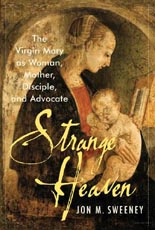"Praying the rosary also involves the lost art of veneration. It used to be that Christians knew how to adore God, in Christ, and to venerate the saints, but this is not as true, anymore. To venerate involves both reverence and love combined together; it is felt in the heart and seen in the eyes. It is cultivated in silence, serenity, and communion. Veneration is the key to understanding the 'look' of Mary in many of the most famous paintings depicting her at prayer.
"The construction of rosaries varies according to tradition. Anglican rosaries usually have thirty-three beads representing each of the thirty-three years of Christ's earthly life. Orthodox Christian monks still tie strings of 100 knots called chotki (Russian) or komvoskoini (Greek). The traditional Catholic rosary is composed of fifteen decades (i.e., ten beads), each decade consisting of the Our Father, ten Hail Marys, and the Glory Be to the Father, and each being recited in honor of some mystery in the life of Our Lord and of his Blessed Mother. During each decade we should call to mind the mystery that it is intended to honor, and pray that we may learn to practice the virtue specially taught us by that mystery.
"The way of using a rosary is quite simple. The string of beads is held loosely in the left hand, usually to allow the cross at the head of the bead string to dangle. The prayers are begun by grasping the cross in the right hand and praying with it. Most of the prayers used with a rosary are prescribed, short, repetitions; they vary from Catholic to Anglican and other traditions. Some traditions will have one pray with the cross: 'In the name of the Father, Son, and Holy Spirit. Amen' as a way of beginning things. The traditional Roman Catholic rosary begins with the saying of the Apostle's Creed and making of the sign of the cross. Moving through the other beads — which are of varying sizes — the prayers include Hail Marys (said on the small, uniform beads), Our Fathers (said on the less frequent large beads), and Glory Be's ('Glory be to the Father, the Son, and the Holy Spirit. As it was in the beginning, is now, and ever shall be, world without end. Amen.'), said at the end of each decade of small beads. Then, the 'mysteries' are announced, meditated upon, followed by more Our Fathers, Hail Marys, and Glory Be's. Many Catholics will follow Pope John Paul II's recent advice to pray certain 'mysteries' (see below) on certain days: Joy on Monday and Saturday; Light on Thursday; Sorrow on Tuesday and Friday; and Glory on Wednesday and Sunday. Two exceptions are made based on the season: Sundays during Christmas — Joy; and Sundays during Lent — Sorrow.
